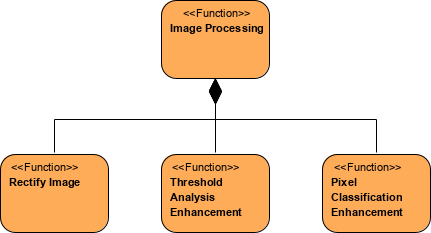An SV-4 specifies the functions carried out by all types of Resource, including organisational resources.
The primary purposes of the SV-4 are to:
- Specify the behaviour of resources in the architecture.
- Develop a clear description of the necessary data flows that are input (consumed) by and output (produced) by each resource.
- Ensure that the functional connectivity is complete (i.e. that a resource’s required inputs are all satisfied).
- Provide implementation-specific realisations of the operational activities specified in OV-5, Operational Activity Model.
The Functionality Description provides detailed information regarding the:
- Allocation of functions to resources.
- Flow of data between functions.
The SV-4 is the systems view counterpart to the OV-5
Usage
The intended usage of the SV-4 includes:
- Description of task workflow.
- Identification of functional system requirements.
- Functional decomposition of systems.
- Relating human and system functions to provide detail about interactions.
Product Description
The SV-4 is used to specify the functionality of resources in the architecture. SV-4 is the functional counterpart to the structures specified in SV-1, Resource Interaction Specification, (in the same way that OV-5 is the functional counterpart to OV-2, Operational Node Connectivity Description).
The scope of this view may be capability wide, without regard to which resources perform which functions, or it may be resource-specific (usually with the resources depicted as swimlanes).
There are two diagrams to depict activity models, as explained below.
Functionality Description
The functional hierarchy shows a decomposition of functions depicted in a tree structure and is typically used where tasks are concurrent but dependent, for example, on a production line.
Functionality Flow Description
The functional flow diagram shows functions connected by data and control flow arrows.
The functional hierarchy approach may be particularly useful in capability-based acquisition where it is necessary to model the functions that are associated with particular capability configurations depicted in the SV-1.
Within a system architecture, SV-4 flow diagrams document resource functions and the flows of data between those functions. Any type of resource may be used in an SV-4, and it is often used to depict the functional interactions between people and systems.
Creating a Functionality Description diagram
To create a Functionality Description diagram:
- Click on Functionality Description in the Action Artifact area, and then select Create New Diagram.
- Type the diagram name and press Enter.
- A blank diagram is created and you can start constructing the view. Create Functions through the tool under the diagram toolbar.
Creating a Functionality Flow Description diagram
To create a Functionality Flow Description diagram:
- Click on Functionality Flow Description in the Action Artifact area, and then select Create New Diagram.
- Type the diagram name and press Enter.
- A blank diagram is created and you can start constructing the view. Create the activity flows with FunctionActions and other flow elements (e.g. Control Flows, Decision Nodes, etc).
Functionality Description

Functionality Flow Description

MODAF in Visual Paradigm
The MODAF is brought to you by Visual Paradigm, a full-featured development platform. Visual Paradigm provides an easy-to-use, model-driven MODAF tool that supports the development of MODAF views and models. You can create integrated MODAF products and generate architectural documents that facilitate organizations to efficiently coordinate enterprise architecture initiatives.